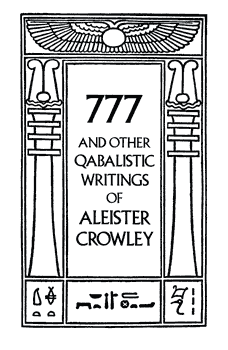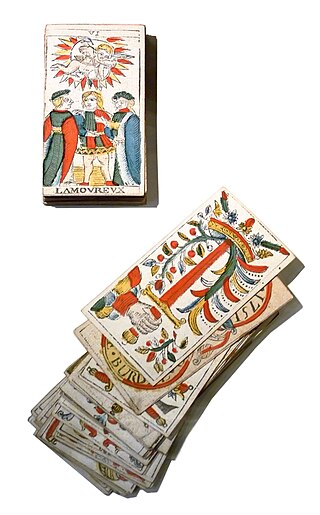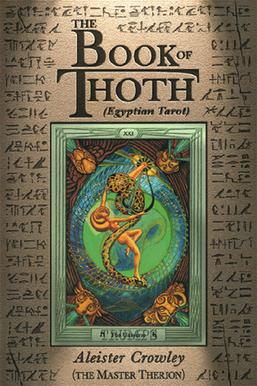
Tarot is a pack of playing cards, used from at least the mid-15th century in various parts of Europe to play card games such as Tarocchini. From their Italian roots, tarot-playing cards spread to most of Europe, evolving into a family of games that includes German Grosstarok and modern games such as French Tarot and Austrian Königrufen. In the late 18th century French occultists made elaborate, but unsubstantiated, claims about their history and meaning, leading to the emergence of custom decks for use in divination via tarot card reading and cartomancy. Thus, there are two distinct types of tarot packs in circulation: those used for card games and those used for divination. However, some older patterns, such as the Tarot de Marseille, originally intended for playing card games, are occasionally used for cartomancy.

The Major Arcana are the named or numbered cards in a cartomantic tarot pack, the name being originally given by occultists to the trump cards of a normal tarot pack used for playing card games. There are usually 22 such cards in a standard 78-card pack, typically numbered from 0 to 21. The name is not used by tarot card game players.

Death (XIII) is the 13th trump or Major Arcana card in most traditional tarot decks. It is used in tarot card games as well as in divination. The card typically depicts the Grim Reaper, and when used for divination is often interpreted as signifying major changes in a person's life.

777 and Other Qabalistic Writings of Aleister Crowley is a collection of papers written by Aleister Crowley. It is a table of magical correspondences. It was edited and introduced by Dr. Israel Regardie, and is a reference book based on the Hermetic Qabalah.

The Equinox is a periodical that serves as the official organ of the A∴A∴, a magical order founded by Aleister Crowley. Begun in 1909, it mainly features articles about occultism and magick, while several issues also contained poetry, fiction, plays, artwork, and biographies. The most recent issue was published in 1998.

Strength is a Major Arcana tarot card, and is numbered either XI or VIII, depending on the deck. Historically it was called Fortitude, and in the Thoth Tarot deck it is called Lust. This card is used in game playing as well as in divination.

Justice is a Major Arcana tarot card, numbered either VIII or XI, depending on the deck. This card is used in game playing as well as in divination.
Abrahadabra is a word that first appeared in The Book of the Law, the central sacred text of Thelema. Its author, Aleister Crowley, described it as "the Word of the Aeon, which signifieth The Great Work accomplished." This is in reference to his belief that the writing of Liber Legis heralded a new Aeon for mankind that was ruled by the god Ra-Hoor-Khuit. Abrahadabra is, therefore, the supreme magical formula of this new age. It is not to be confused with the Word of the Law of the Aeon, which is Thelema, meaning "Will".

The Tarot of Marseilles is a standard pattern of Italian-suited tarot pack with 78 cards that was very popular in France in the 17th and 18th centuries for playing tarot card games and is still produced today. It was probably created in Milan before spreading to much of France, Switzerland and Northern Italy. The name is sometimes spelt Tarot of Marseille, but the name recommended by the International Playing-Card Society is Tarot de Marseille, although it accepts the two English names as alternatives. It was the pack which led to the occult use of tarot cards, although today dedicated decks are produced for this purpose.

Marguerite Frieda Harris, Lady Harris, referred to, by her own insistence, as Lady Frieda Harris, was an English artist and, in later life, an associate of the occultist Aleister Crowley. She is best known for her design of Crowley's Thoth tarot deck.
Minchiate is an early 16th-century card game, originating in Florence, Italy. It is no longer widely played. Minchiate can also refer to the special deck of 97 playing cards used in the game. The deck is closely related to the tarot cards, but contains an expanded suit of trumps. The game was similar to but more complex than tarocchi. The minchiate represents a Florentine variant on the original game.
Heru-ra-ha is a composite deity related to ancient Egyptian mythology revered within Thelema, a religion that began in 1904 with Aleister Crowley and The Book of the Law. Heru-ra-ha is composed of Hoor-paar-kraat and Ra-Hoor-Khuit. He is associated with the other two major Thelemic deities found in The Book of the Law, Nuit and Hadit. The Stele of Ankh-ef-en-Khonsu, known within Thelema as the "Stele of Revealing", links Nuit, Hadit, and Ra-Hoor-Khuit to the ancient Egyptian deities Nut, Behdety, and Ra-Horakhty.
Aleister Crowley was an English writer, not only on the topic of Thelema and magick, but also on philosophy, politics, and culture. He was a published poet and playwright and left behind many personal letters and daily journal entries. Most of Aleister Crowley's published works entered the public domain in 2018.

The Book of Thoth: A Short Essay on the Tarot of the Egyptians is the title of The Equinox, volume III, number 5, by English author and occultist Aleister Crowley. The publication date is recorded as the vernal equinox of 1944 and was originally published in an edition limited to 200 numbered and signed copies.

In ceremonial magic, a magical formula or a word of power is a word that is believed to have specific supernatural effects. They are words whose meaning illustrates principles and degrees of understanding that are often difficult to relay using other forms of speech or writing. It is a concise means to communicate very abstract information through the medium of a word or phrase.

Hermetic Qabalah is a Western esoteric tradition involving mysticism and the occult. It is the underlying philosophy and framework for magical societies such as the Golden Dawn, has inspired esoteric Masonic organizations such as the Societas Rosicruciana in Anglia, is a key element within the Thelemic orders, and is important to mystical-religious societies such as the Builders of the Adytum and the Fellowship of the Rosy Cross.

Tarot card reading is a form of cartomancy whereby practitioners use tarot cards to purportedly gain insight into the past, present or future. They formulate a question, then draw cards to interpret them for this end. A traditional tarot deck consists of 78 cards, which can be split into two groups, the Major Arcana and Minor Arcana. French-suited playing cards can also be used; as can any card system with suits assigned to identifiable elements.

James Wasserman was an American writer and occultist. A member of Ordo Templi Orientis since 1976 and a book designer by trade, he wrote extensively on spiritual and political liberty.

U.S. Games Systems, Inc. (USGS) is a publisher of playing cards, tarot cards, and games located in Stamford, Connecticut. Founded in 1968 by Stuart R. Kaplan, it has published hundreds of different card sets, and about 20 new titles are released annually. The company's product line includes children's card games, museum products, educational cards, motivational cards, tarot cards, and fortune telling decks. These are marketed through a network of retailers, including bookstores, museum gift shops, metaphysical shops, greeting card stores; toy and game stores; hobby shops, and mail order catalogs.
The Book of Thoth can be one of multiple books discussed in the article linked in this sentence. The term may also refer to:
















